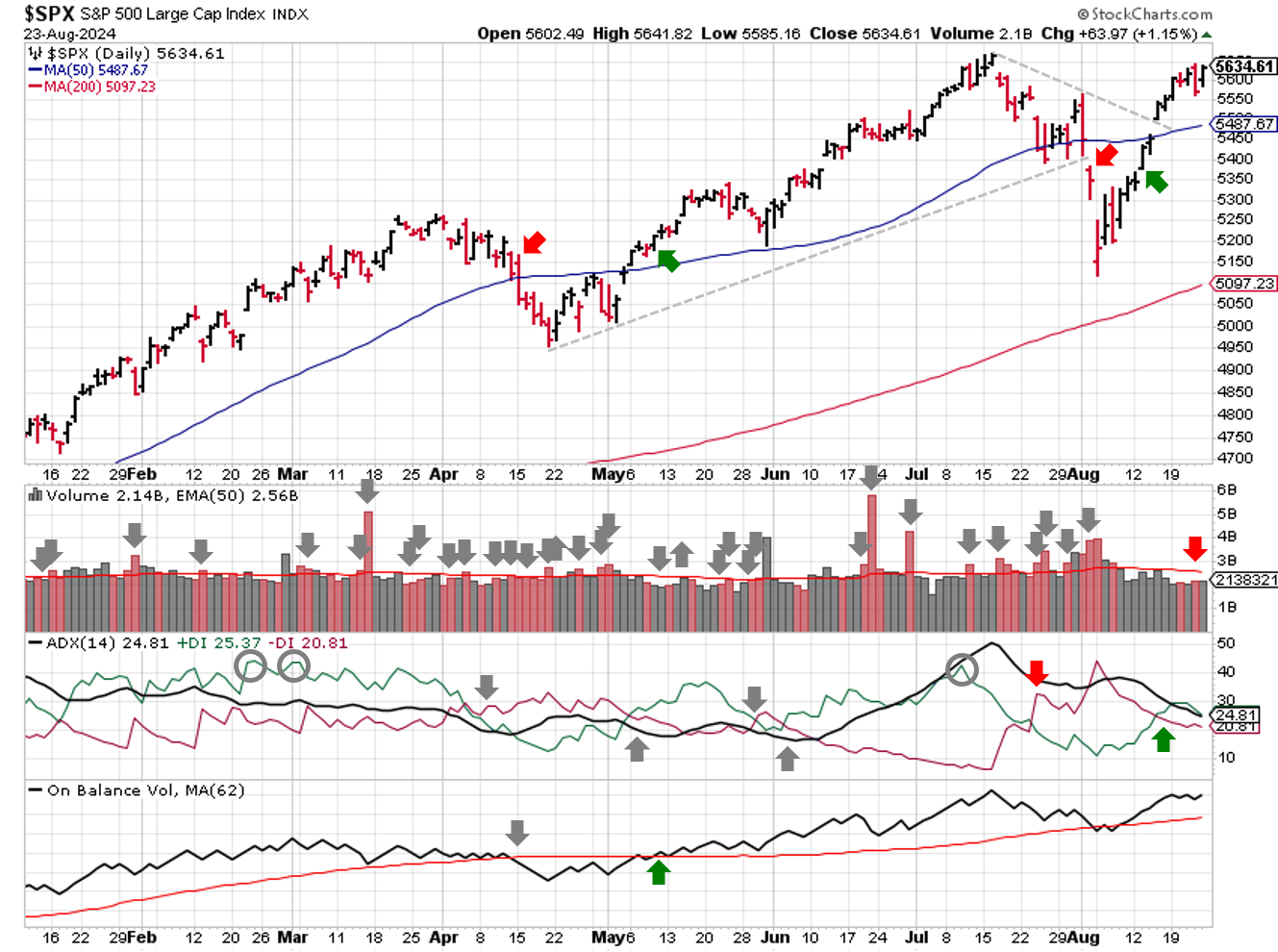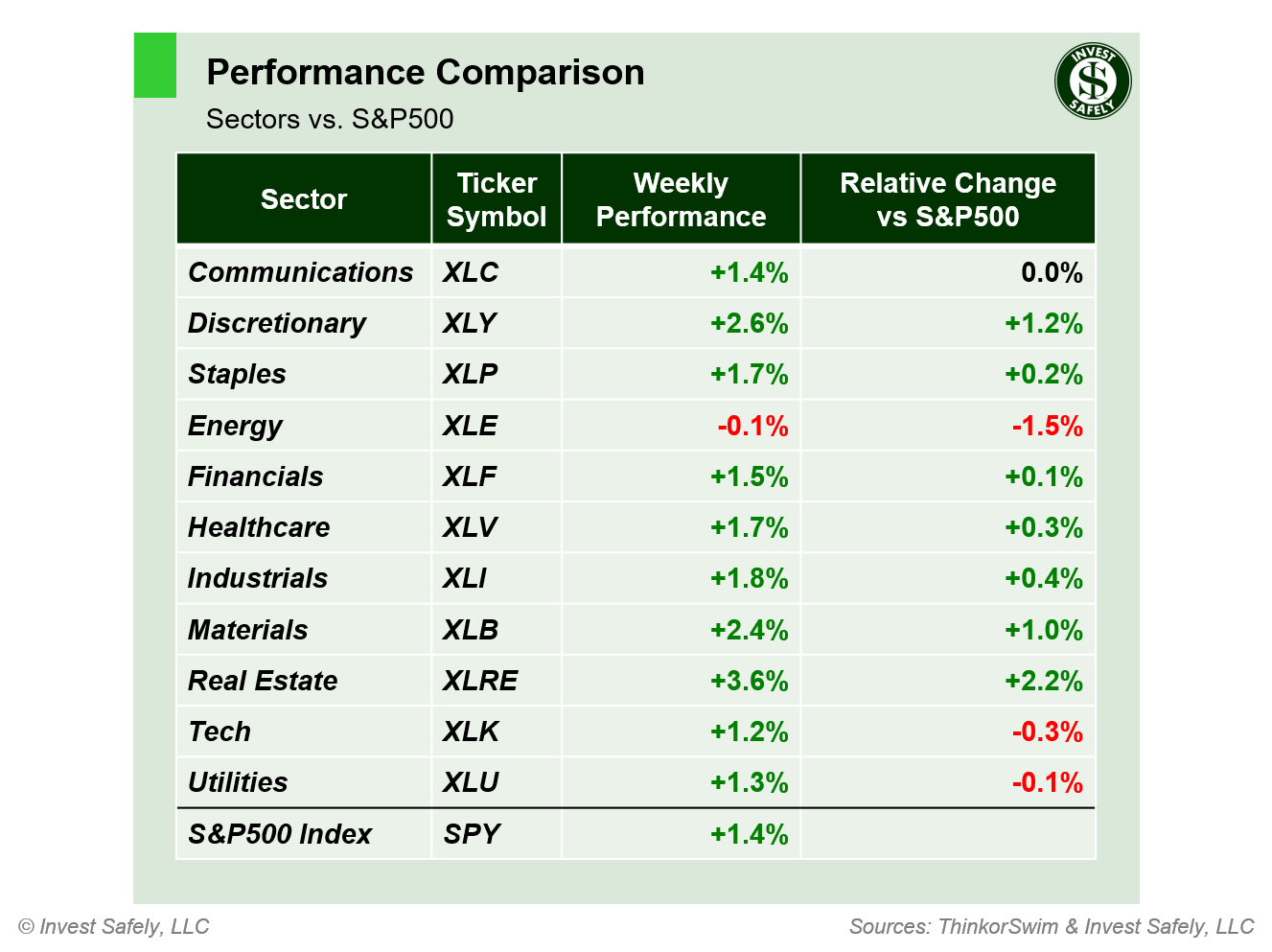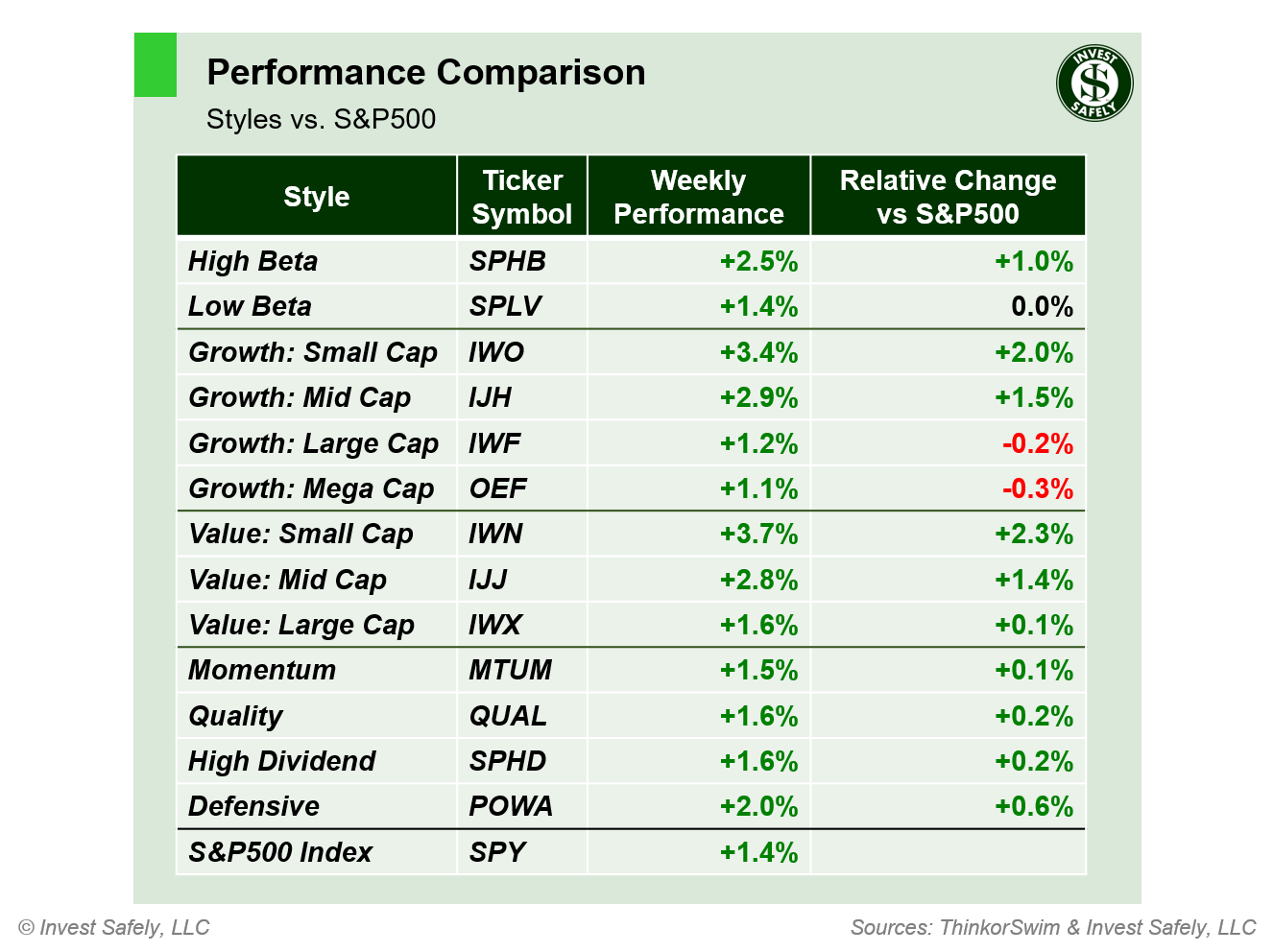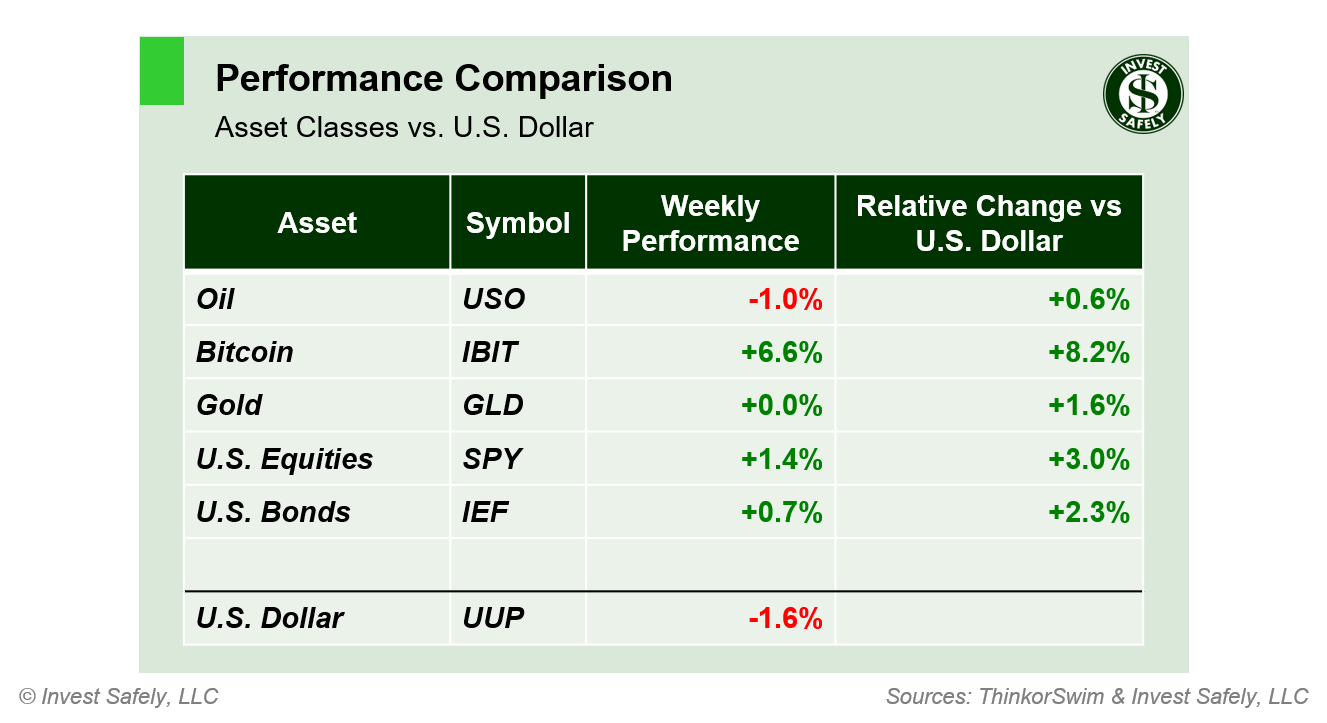Stock Market Outlook
For The Week Of August 25th =
Uptrend
INDICATORS
-
ADX Directional Indicators: Uptrend
Price & Volume Action: Uptrend
On Balance Volume Indicator: Uptrend
The stock market outlook shows an uptrend in place, with equities looking to close out August at all time highs.
The S&P500 ($SPX) rose 1.4% last week. The index sits ~3% above the 50-day moving average and ~11% above the 200-day moving average.
SPX Technical Analysis - August 25 2024
All three signals show bullish action. Index volume remains below average, which is expected during sessions at the end of August. Traders and their volume should return to their desks after Labor Day.
Real Estate ($XLRE) led the way last week, although most sectors advanced for the week. Energy sector ($XLE) was the lone holdout and worst performer, largely due to oil's underperformance and correlation to the U.S. dollar (more below).
All sector styles had positive returns last week: Small Caps (growth & value) led the way, while large and mega cap growth underperformed the general market.
Asset classes benefited from continued weakness in the U.S. dollar. Bitcoin let assets higher, while Oil underperformed. Over the past 3 weeks, moves in oil and the dollar are highly correlated, while dollar correlations with the other assets classes are negative.
COMMENTARY
A rather large, negative revision to non-farm payrolls hit the wires midweek, suggesting the labor market hasn't been as robust as experts believed. Given employment is now the focus of the FOMC (rather than inflation), it's no surprise that Federal Reserve Chairman Powell said the time has come to cut interest rates during his Friday speech.
Markets rejoiced. Media outlets were quick to highlight the coming change, saying that inflation is no longer an issue (wrong), and consumers will find relief in the form of lower payments on debt (new mortgages, credit card balances, etc.). Probably a bridge too far, and a dangerous one at that, but you know what they say: "Never let the truth ruin a good story".
Next week, all eyes are on Nvidia; they release quarterly earnings Wednesday after market close. The data will serve as a catalyst for market moves, given $NVDA's importance to the artificial intelligence narrative and semi-conductor supply chain, as well as the stocks relative high index weighting. They've blown past targets the past few quarters. Lets hope market participants are equally impressed this time around, or it could be a rough start to September.
The market also gets July Durable Goods data on Monday, the 2nd Q2 GDP estimate on Thursday, and July PCE on Friday.
Best to Your Week!
P.S. If you find this research helpful, please tell a friend.
If you don't, tell an enemy.
Sources: Bloomberg, CNBC, Federal Reserve Bank of St. Louis, Hedgeye, U.S. Bureau of Economic Analysis, U.S. Bureau of Labor Statistics
Share this Post on:

How to Make Money in Stocks: A Winning System in Good Times and Bad.
It's one of my favorites.
I regularly share articles and other news of interest on:
Twitter (@investsafely)
Facebook (@InvestSafely)
LinkedIn (@Invest-Safely)
Instagram (@investsafely)
Invest Safely, LLC is an independent investment research and online financial media company. Use of Invest Safely, LLC and any other products available through invest-safely.com is subject to our Terms of Service and Privacy Policy. Not a recommendation to buy or sell any security.
Charts provided courtesy of stockcharts.com.
For historical Elliott Wave commentary and analysis, go to ELLIOTT WAVE lives on by Tony Caldaro. Current counts can be found at: Pretzel Logic, and 12345ABCDEWXYZ
Once a year, I review the market outlook signals as if they were a mechanical trading system, while pointing out issues and making adjustments. The goal is to give you to give you an example of how to analyze and continuously improve your own systems.
- 2015 Performance - Stock Market Outlook
- 2016 Performance - Stock Market Outlook
- 2017 Performance - Stock Market Outlook
- 2018 Performance - Stock Market Outlook
- 2019 Performance - Stock Market Outlook
- 2020 Performance - Stock Market Outlook
IMPORTANT DISCLOSURE INFORMATION
This material is for general communication and is provided for informational and/or educational purposes only. None of the content should be viewed as a suggestion that you take or refrain from taking any action nor as a recommendation for any specific investment product, strategy, or other such purpose. Certain information contained herein has been obtained from third-party sources believed to be reliable, but we cannot guarantee its accuracy or completeness.
To the extent that a reader has any questions regarding the applicability of any specific issue discussed above to his/her individual situation, he/she is encouraged to consult with the professional advisors of his/her choosing. Invest Safely, LLC is not a law firm, certified public accounting firm, or registered investment advisor and no portion of its content should be construed as legal, accounting, or investment advice.
The material is not to be construed as an offer or a recommendation to buy or sell a security nor is it to be construed as investment advice. Additionally, the material accessible through this website does not constitute a representation that the investments described herein are suitable or appropriate for any person.
Hypothetical Presentations:
Any referenced performance is “as calculated” using the referenced funds and has not been independently verified. This presentation does not discuss, directly or indirectly, the amount of the profits or losses, realized or unrealized, by any reader or contributor, from any specific funds or securities.
The author and/or any reader may have experienced materially different performance based upon various factors during the corresponding time periods. To the extent that any portion of the content reflects hypothetical results that were achieved by means of the retroactive application of a back-tested model, such results have inherent limitations, including:
Model results do not reflect the results of actual trading using assets, but were achieved by means of the retroactive application of the referenced models, certain aspects of which may have been designed with the benefit of hindsight
Back-tested performance may not reflect the impact that any material market or economic factors might have had on the use of a trading model if the model had been used during the period to actually manage assets
Actual investment results during the corresponding time periods may have been materially different from those portrayed in the model
Past performance may not be indicative of future results. Therefore, no one should assume that future performance will be profitable, or equal to any corresponding historical index.
The S&P 500 Composite Total Return Index (the "S&P") is a market capitalization-weighted index of 500 widely held stocks often used as a proxy for the stock market. Standard & Poor's chooses the member companies for the S&P based on market size, liquidity, and industry group representation. Included are the common stocks of industrial, financial, utility, and transportation companies. The S&P is not an index into which an investor can directly invest. The historical S&P performance results (and those of all other indices) are provided exclusively for comparison purposes only, so as to provide general comparative information to assist an individual in determining whether the performance of a specific portfolio or model meets, or continues to meet investment objective(s). The model and indices performance results do not reflect the impact of taxes.
Investing involves risk (even the “safe” kind)! Past performance does not guarantee or indicate future results. Different types of investments involve varying degrees of underlying risk. Therefore, do not assume that future performance of any specific investment or investment strategy be suitable for your portfolio or individual situation, will be profitable, equal any historical performance level(s), or prove successful (including the investments and/or investment strategies describe on this site).






